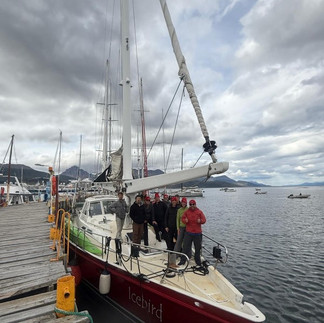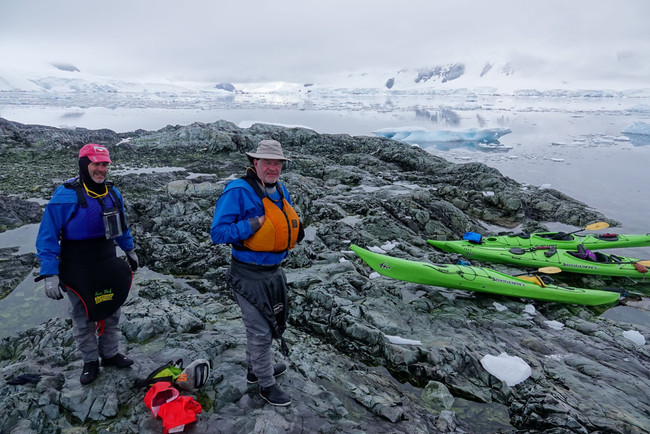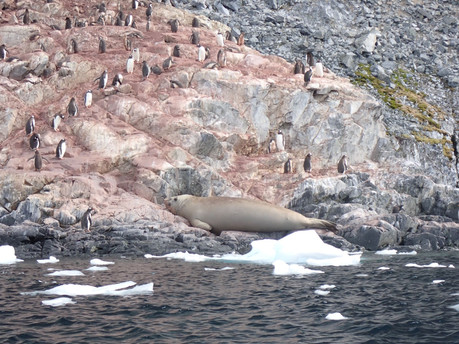Paddling the Polar Ice: A Detailed Itinerary of My Antarctica Kayak Adventure
- Ruth Bergman

- Mar 10
- 16 min read
Updated: Mar 25
Antarctica is a truly unique destination, and a dedicated kayak-focused expedition is rare enough that I believe our itinerary is worth documenting in detail. This post aims to do just that. To the best of my recollection, I’ll outline the locations we visited, where we spent each night, and, most importantly, our kayaking routes. While I’ll briefly mention the landscapes and wildlife we encountered, I’ll save in-depth descriptions for future posts.
Unlike my usual storytelling style, this post will be more factual than inspirational. It may serve as both a personal record and a useful resource for others researching or planning a similar trip. Our kayak routes are likely unique, as kayaking from expedition cruise ships offers a very different experience—typically limited to short excursions.
Day 1-2: Waiting in Ushuaia Harbor
We arrived at our sailboat, Icebird, docked in Ushuaia Harbor on February 3, expecting to set sail that afternoon. However, upon arrival, we found that repairs were still underway. Although we completed immigration formalities in the afternoon, it quickly became clear that we would not be departing that day.
By the following afternoon, both the rudder and alternator were mostly repaired, though final adjustments were still ongoing. Rather than recount the full range of emotions felt by the group, I’ll summarize the key development: our kayak guide chose to withdraw from the expedition. The rest of the passengers remained, hopeful that we can still have the trip we have dreamed of for so long. Later that day, the captain announced that we were ready to depart—but with the change in our passenger list, we needed to redo the exit paperwork before setting off.
Day 3: We're off and Motoring the Beagle Channel
On February 5, a routine inspection of the boat uncovered a missing document. Fortunately, it was quickly located, printed, and processed within a few hours. By the afternoon, we had received clearance to depart.
At 5 p.m., to the cheers of nearby boats, we finally pushed off from the dock. As we motored down the Beagle Channel, we took in the stunning mountain views of Argentina on one side and Chile on the other, marking the true beginning of our journey.
Day 4-6: The Drake Passage
The next 3 days, Feb 6-8, we sailed through the Drake Passage seeing nothing but Ocean and the occasional bird for three full days. See my post about crossing the Drake Package.
Day 7: Arrive Antarctica, Icebergs, Fur Seals, Melchior Base and Champagne
On our fifth day on the water, February 9, we began spotting more birds, followed by penguins and a few scattered icebergs. Over the next few hours, the icebergs became more frequent, eventually leading to our first sight of land—blanketed, of course, in snow.
Our point of arrival in Antarctica was Melchior Islands, a small archipelago nestled between two larger landmasses. From aboard Icebird, we observed a fur seal colony before stepping onto Antarctic land for the first time—though not the mainland—at Melchior Base. There, we marked the occasion by toasting with champagne at the refuge. We spent the night anchored between the small islands of Eta and Omega, finally beginning our Antarctic experience.
Day 8: First Paddle, Neumayer Channel, Port Lockroy
On February 10, we began the day by preparing the kayaks, reattaching and adjusting the rudders that had been removed for the Drake Passage crossing. The process took nearly three hours, with mixed success—throughout the trip, the rudders functioned only partially at best. While not essential, they proved useful in rougher conditions, particularly in wind and waves.
Once all six kayakers were in the water, we embarked on a short warm-up paddle before reboarding the boat—an exercise we steadily improved upon throughout the expedition. It quickly became clear that we had two distinct kayaking groups, as the less experienced paddlers hesitated to venture beyond the protection of the channel when the wind picked up. The paddling statistics in this narrative reflect the journeys of me, Oren, and Erik—the stronger kayak group—who embarked on self-guided paddles for the remainder of the trip. The less experienced group was accompanied by a crew member in a dinghy (a small Zodiac-type boat) for their outings.
Back on the boat, we continued south, motoring past the Parker Peninsula and through the breathtaking Neumayer Channel, eventually reaching a quiet bay near Port Lockroy. With clear blue skies, we were treated to a spectacular sunset over glaciers and ice. That night, we anchored at Port Lockroy, ready for the next stage of our journey.
Paddle day 1, lovely warmup paddle, introduction to glaciers, ice and seals
Distance 10.51 km
Time 2:11:25
Conditions: sunny and flat, protected water in the channel getting a little choppy in the bay
Day 9: First Penguin Colony, Icy Paddle down Lemaire Channel, Ship with Two Masts
I've completely lost track of time—no idea what day or date it is anymore.
Port Lockroy is a common stop for visitors to the Antarctic Peninsula, but the British station crew slept in and missed our call. We weren’t too disappointed to skip the chance to send mail and browse the museum and gift shop.
Instead, we made our first visit to a Gentoo penguin colony on Doumer Island, briefly anchoring at South Bay. There, we explored a small museum preserving the history and culture of early Antarctic explorers.
From there, we crossed the Bismarck Strait to Lemaire Channel, where we launched our kayaks for a spectacular paddle on glassy waters, flanked by towering glaciers and surrounded by icebergs. Along the way, we spotted several seals and humpback whales from our kayaks and even witnessed a large ice calving. Thankfully, we were at a safe distance—far enough to admire the spectacle without concern.
Continuing around Pléneau Island, we searched for a sheltered bay, which we identified by the presence of a two-masted ship already anchored there. We paddled from 4 p.m. to 9 p.m., but with such breathtaking scenery, time hardly mattered. That night, we docked alongside the other vessel, and savored this beautiful day.
Paddle day 2 - iconic Antarctic paddle
Distance 18.49 km
Moving Time 4:01:34, Elapsed Time 4:55:23
Conditions were perfect, flat, glassy water, no wind, lots of ice, and still sunny
Day 10: A Paddle with Big Ice, Lunch Break with a Calving, Hike with a View
We set out on a full-day kayak trip, paddling from Pléneau Island to the far side of Booth Island. The journey involved a three-mile crossing, weaving through towering icebergs. At one point, we found ourselves on top of an iceberg, having erroneously judged the two protruding chunks of ice to be separate icebergs —a surreal and awe-inspiring moment.
For lunch, we stopped at the tip of Booth Island, where a curious penguin approached us, and we witnessed an iceberg breaking apart uncomfortably close. We were grateful to be on solid ground at that moment.
After lunch, we continued around the peninsula into a large bay, where conditions shifted, and we faced a headwind. We followed the shore of Booth Island, and from our kayaks, observed a penguin colony before deciding to return to Icebird, anchored nearby.
Once back on the boat, we set out on a hike up a nearby hill, passing through the same penguin colony on our way to a cross at the summit. The vantage point offered a breathtaking panoramic view of the archipelago and the icebergs below.
At the end of the day, we returned to our familiar anchorage at Pléneau Island for the night.
Paddle day 3 - close encounters with big icebergs
Distancce 17.00 km
Moving Time 3:45:52, Elapsed Time 5:32:59
Conditions - flat water through the crossing, wind around Booth Island. Lots of large icebergs. Partly cloudy
Day 11: Petermann Island, Adelie Penguins, Vernadsky Station
Leaving Pléneau Island, we continued south to Petermann Island, where we visited another penguin colony and took a short hike. We landed near a small building on the east side of the island. Although Petermann is known to host multiple penguin species, we only spotted Gentoo penguins during our visit.
Next, we headed farther south to the Yalour Islands in search of Adélie penguins. Along the way, we spotted a leopard seal resting on an iceberg. Here, we launched our kayaks to paddle between the islands, making our way toward Waddington Bay before returning to the boat at our scheduled meeting time.
From there, we continued paddling across the channel toward Argentine Islands and Vernadsky Station, with the ship following us. Without a map in hand, we relied on our captain’s descriptions to navigate. We quickly learned that landmarks appear quite different from a kayak than from a ship, but we successfully located the correct channel and arrived at Vernadsky Station, where we spent the night.
After this experience, we made sure to download the iSailor app with a proper Antarctic chart, which proved invaluable for navigation during the rest of our paddling days.
Paddling day 4 - an Antarctic meander between islands and mainland
Distance 17.31 km
Moving Time 3:27:23, Elapsed Time 4:13:11
Conditions: gray sky, flat, glassy water, lots of icebergs, some snow
Day 12: Circumnavigate an Archipelago, Fog, a Museum and Tourists
This morning, we set out to circumnavigate the archipelago surrounding Vernadsky Station, gaining firsthand experience of how quickly sea conditions can change. Within the shelter of the islands, the water was calm, but as soon as we rounded Leopard Island at the southern end of the archipelago, the wind and waves picked up. As we continued, we're back to beautiful calm conditions and as we rounded the northern Uruguay Island, we're once again exposed to wind and waves.
To reach the Penola strait to the east, we navigated through a narrow channel packed with dense icebergs, which required careful maneuvering. On the strait, we encountered thick fog. Fortunately, we were able to follow the islands to our right and retrace our route from the previous day, which helped boost our confidence despite the limited visibility. Upon returning to Icebird at Vernadsky, the crew kindly warmed up a lunch of spaghetti with vegetable ragout, which was much appreciated after the chilly morning on the water.
In the afternoon, we visited an abandoned British base, now preserved as a museum. However, we had to share the space with passengers from a small cruise ship, witnessing for the first time the chaotic scene of zodiacs ferrying groups of identically dressed tourists to and from shore. We took a short walk up a nearby hill, but with the heavy fog, the view was less than spectacular.
That evening, we spent another night at Vernadsky Station. We had hoped to visit the station itself, but unfortunately, the staff informed us they were too busy to accommodate visitors.
Paddle day 5 - excursion around Vernadsky
Distannce 14.22 km
Moving Time 2:54:14, Elapsed Time 3:22:20
Conditions mixed, calm within the archipelago with winds and wave when exposed to the ocean, snow in the morning, fog in the latter half
Day 13: Motor to Paradise Bay
The bad weather persisted as we woke up to snow and low-hanging clouds. After five days of continuous paddling, we were content to take a break. Instead, we made it a sailing day, motoring about 50 miles to Paradise Bay on the Antarctic mainland.
Despite the rough conditions, Antarctica never fails to provide spectacular sights. Along the way, we passed towering, snow-covered peaks, breathtaking icebergs, and encountered an array of wildlife. We spotted humpback whales, a leopard seal lounging on an iceberg, and upon reaching our anchorage in Paradise Bay, we watched a seal demonstrate the impressive skill of hauling itself onto the ice.
From a photography standpoint, the boat offers a clear advantage, with its higher vantage point allowing for sharper, more dynamic shots of wildlife. But nothing compares to the experience of being in a kayak—at eye level with seals and penguins, gliding silently through their world, feeling completely immersed in their natural habitat.
We spent the night in Paradise Bay, in a small bay right behind Brown Station.
Day 14: A Dream Paddle, Whales and more Whales, Stepping on the mainland
We set out for a full-day paddle, finishing around 2 p.m. The cold was relentless—every day was cold—but spending five and a half hours outside meant frozen hands and feet. Despite the chill, it was hard to end this paddle. The setting was truly surreal. We navigated through towering glaciers that formed stunning bays, with the breathtaking Leith Cove as our destination. We weaved through floating ice calved from the glaciers, fully immersed in the moment. The soundtrack to this spectacular scene was the cracking of ice, the distant rumble of avalanches, and the rhythmic exhalations of whales. Everywhere we looked, pairs of whales surfaced, adding to the magic of the experience.
For lunch, we stepped onto the Antarctic mainland for the first time, marking a special moment in our journey. After our break, we continued paddling through the bays, closely observing a whale until a couple of cruise ship zodiacs arrived and interrupted the silence.
Back aboard Icebird, we set off to visit the Argentinian Brown Station. One of the advantages of traveling on a small boat is access—while larger ships were denied, we were welcomed as a small group of visitors. We climbed a steep hill for a panoramic view of Paradise Bay before enjoying a fun slide back down.
That night, we remained anchored in Paradise Bay, taking in the stillness of this extraordinary place.
Paddle day 6 - best ever wildlife experience from a kayak, and a landing on the mainland
Distance 16.52 km
Moving Time 3:27:31, Elapsed Time 5:26:39
Conditions: gray sky and scattered snow, glassy water
Day 15: Paddle to Gonzales station, Waking a giant, Danco Island
Today, we continued our journey north, with three of us paddling in kayaks while the rest traveled aboard Icebird. Retracing part of yesterday’s route, we passed by Leith Cove before following the channel toward the Chilean González Base and Molina Point. Along the way, we were entertained by whales, seals, and penguins, with one particular humpback that we may have woken up from its slumber.
Beyond the Chilean base, the narrow channel opened into a wider strait, where the wind picked up. At that point, we boarded Icebird to safely cross the rougher waters.
Our next stop was Danco Island, home to a large penguin colony. We hiked alongside the penguins to the top of the hill, taking in the expansive views. That night, we anchored between Cuverville and Rongé Islands, settling in for another night in Antarctica’s wild beauty.
Paddle day 7 - up close encounter with a whale
Distance 12.40 km
Moving Time 2:33:41, Elapsed Time 2:46:58
Conditions: gray sky, calm water, and windy in the final open bay
Day 16: Paddle with Wind, Penguins Superhighway, Chin Strap Penguins, Humpback Show
The day began with a paddle through the channel between Rongé Island and the mainland. In Antarctica, we were learning, seals and penguins are everywhere. As we continue north, calm and pleasant conditions are becoming less common, replaced by rougher, more unpredictable waters. Rounding the corner of Rongé Island, we encountered strong winds and a small swell for the first time. Not wanting to take unnecessary risks, we turned back, planning to stop at the penguin colony on Danco Island—only to find a cruise ship had arrived ahead of us. Instead, we opted to circle Cuverville Island, admiring its striking rock formations and bustling penguin colony. Along the way, we had our first sighting of an elephant seal lounging among the penguins.
Back aboard Icebird, the adventure continued on the far side of Rongé Island. We explored a small bay and embarked on a steep, challenging hike to a chinstrap penguin colony, where we were rewarded with a breathtaking view and good entertainment. A pod of humpback whales followed us into the bay and lingered there throughout our hike—putting on a show even SeaWorld couldn't replicate.
From there, we motored a fair distance to the wreck of the Governoren, a whaling ship that sank in 1915, where we anchored for the night.
Paddle day 8 - never a dull paddle, from ice to wind to penguins
Distance 16.71 km
Moving Time 3:32:38, Elapsed Time 6:07:50
Conditions - windy
Day 17: A Paddle of varied conditions, Whaling History
We set off for another long paddle from the Governoren, though the briefing from our ship’s captain was less than precise. “It should be good around this island. The wind should be with you on the way back, but winds are changing, so who knows? It depends on the weather.” He wasn’t wrong—conditions shifted around every corner. The most extreme stretch brought half an hour of powerful winds and high swells with whitecaps. With water temperatures below freezing, the very real risk of capsizing was nerve-wracking. Fortunately, we made it back to calmer waters and had time to take in the many remnants of the area’s whaling history.
We spent the afternoon sheltering from the worsening weather and spent another night docked at the wreck of the Governoren.
Paddle day 9 - shifting conditions make for a scary paddle
Distance 17.61 km
Moving Time 3:28:02, Elapsed Time 3:58:59
Conditions: changing winds, strong gusts in parts with .5m swell and whitecaps, scary
Day 18: Motor to Trinity Island
This was our one quiet day with no activities. We motored about 50 miles to Trinity Island, bidding farewell to the receding Antarctic mainland as the icebergs became fewer and farther between. That night, we anchored at Trinity Island, acutely aware that our journey was nearing its end.
Day 19: Motor to Deception Island, the Orca Show
We set off on another long journey to Deception Island, a volcanic island. It has a small opening into its caldera, which when conditions allow, vessels can navigate inside, revealing a stark landscape rich with history. Formerly known as Whaler Bay, a whaling station operated by a Norwegian company until 1931, and later Port Foster, a British research base. The base shut down in 1969 following repeated volcanic eruptions. The remnants of these past endeavors are scattered along the narrow beach within the caldera and are well worth exploring. As always, seals and penguins were abundant.
That night, we anchored near an old Chilean base on Deception Island, reflecting on the unforgettable experiences Antarctica presents.
Day 20: Paddle Yankee Harbor, Start of the Bad Weather
We left Deception Island early, navigating through its narrow opening. Just outside, a large cruise ship—too big to enter the caldera—watched our passage. We waved to the excited tourists observing us from the deck. As we moved into the South Shetland Islands, the landscape shifted—dramatic, jagged rock formations interspersed with glaciers lined the shores, creating a striking contrast.
We stopped in front of a towering volcanic rock formation, reminiscent of Devil’s Postpile in California but on a much grander scale. Here, we launched our kayaks for a paddle around Yankee Harbor. The scenery was overwhelming—everywhere I turned, there was something to take in. Should I focus on the intricate rock formations or the two humpback whales surfacing nearby? We stayed close to the bays, mindful of the constant thunder of avalanches from the glaciers shaping them. Twice, we witnessed ice crashing into the water. Hugging the shoreline helped shelter us from the wind, but it also meant navigating through the dense ice pushed into the bays by wind and current. Eventually, we felt close enough to Icebird to cut straight across open water, rewarded with a final exhilarating downwind paddle—complete with a bit of wave surfing. After our last experience in rough waters, I could finally enjoy it rather than fear it.
This marked the end of our kayaking adventure. Back aboard Icebird, we continued to Half Moon Island, anchoring in front of Argentina’s Cámara Base for the night.
Paddle day 10 - last but not least, a beautiful glacial bay
Distance 12.42 km
Time 2:35:37
Conditions: windy in the bay, calm and icy near the bays
Day 21: King George Island, Elephant Seals, A Visit to Carlini Research Base
By now, we're paying attention to the dates again—it’s February 23, and our flight from King George Island is scheduled for tomorrow. We set sail toward our final destination, reveling in the sensations of sailing, the taut sail and the rhythmic sound of wind and waves. Once again, we find ourselves holding onto the rails with every step.
By lunchtime, we reach King George Island and a beautiful bay near the Argentinian Carlini Base. For entertainment, we take a dinghy ride along the shore to observe elephant seals.
To our surprise, the Argentinian research station invites us for a visit, offering us a rare glimpse into life on an Antarctic base. In summer, the station houses 90 people, with 20 staying through the long, isolated winter. We meet several of them and learn some fascinating details: every resident must have their appendix removed before coming to Antarctica, they receive no fresh fruits or vegetables, and winter supplies are completely cut off.
Later, a small group of eight from the base visits us on Icebird. It’s remarkable how meaningful human connection feels in such a remote place—and equally remarkable how many people we manage to fit into Icebird’s cockpit. Over shared wine and a delicious pineapple tarte Tatin, we learn about their research and exchange stories of our experiences.
That night, we anchor near Carlini Base and await news of our flight.
Day 22: The Flight That Wasn't, Bad Weather and Birthday Cake
On the morning of February 24, Icebird is a hive of activity. The crew prepares to sail to the airport, and passengers hurriedly pack their belongings. There seems to be a window for the flight. The sea is rough, with large waves, and the captain exchanges tense messages with the charter company. Before long, we turn back toward Carlini Base—no flight today.
Overnight, fresh snow blankets the rocky formations above the bay, transforming the landscape. But the beauty is accompanied by force—this is the most severe storm I have ever experienced. Winds reach 40 knots (about 70 km per hour), driving the snow sideways. The nearby base is soon obscured by the storm, disappearing into a thick veil of snow and fog. The tempest continues through the night.
With no other activities possible, I take the crew up on their invitation to cook. Navigating the intricacies of the galley, I manage to prepare a hearty Hungarian meal—goulash, nokedli, and cabbage. For dessert, and in honor of a passenger’s birthday, I bake a carrot cake with proper cream cheese frosting. It is well received by all, a small comfort in the midst of the storm and stress.
Bonus Day 23: To the Airport, Russian Church, A Real Hike, and Guests for Dinner
We're on borrowed time now, making the most of it. The morning brings much better weather, steadily improving, so we set off for the airport. The airstrip is located on a Chilean naval base on King George Island, adjacent to the Russian Bellingshausen Station. There, we are granted a visit to Trinity Church—the southernmost Orthodox church—entirely transported from Russia and reassembled in this remote outpost.
Later, we hike across the island to an elephant seal colony, carefully making our way through the snow while ensuring we don't disturb the delicate moss, lounging seals, or waddling penguins.
That evening, we host three guests from the Chilean research base for dinner—sailors eager to meet our Chilean crew member and exchange stories of life at sea.
Although we watch a C-130 Hercules plane land and take off, the airport is not yet prepared for a commercial flight. Our departure is still on hold, rescheduled for the following day. We spend the night anchored in the bay, joined by several other ships also waiting for the flight.
Bonus Day 24: The Plane, The Plane
Amid a flurry of activity, we navigate the logistics of departing Antarctica. Transporting all our gear from the boat to the plane—and getting ourselves there—is nothing like a typical commercial flight. Somehow, everything is whisked from the beach directly to the aircraft, including our passports. We travel dressed in full Antarctic gear—ski clothes and muck boots—hoping our passports are making the journey with us.
The tarmac is snowed over, but the runway has been cleared. When we see the plane, we are happy that the uncertainty is over, but sad to leave this magnificent place. As we board the plane, we receive a piece of chocolate to sweeten the blow.
Antarctica: Unrepeatable and Unforgettable
The phrase that best captures the Antarctic experience is: "It depends on the weather." No two visits to Antarctica are the same. In its ever-changing conditions, some places may be accessible one day and unreachable the next. No two wildlife encounters are alike, either. If I were to return, I have no doubt the experience would be entirely different and just as unique.
Overall, we were fortunate with the weather. We managed to kayak ten times in Antarctica, covering a total of 153 kilometers in every imaginable condition—and some we hadn’t imagined. We encountered nearly every type of Antarctic wildlife near our kayaks. We experienced the continent’s snow and ice under both gray and blue skies, in sunshine and snowfall. We paddled past endless, breathtaking ice formations, saw tens of thousands of penguins, observed every type of seal, witnessed tens of humpback whales, four fin whales, and even twenty or so orcas.
For a more in-depth look at our Antarctic expedition, stay tuned for additional posts. And if you’re considering an Antarctic adventure—GO!
Resources
iSailor app for iPhone has an inexpensive chart for Antarctica



















































































































































Comments